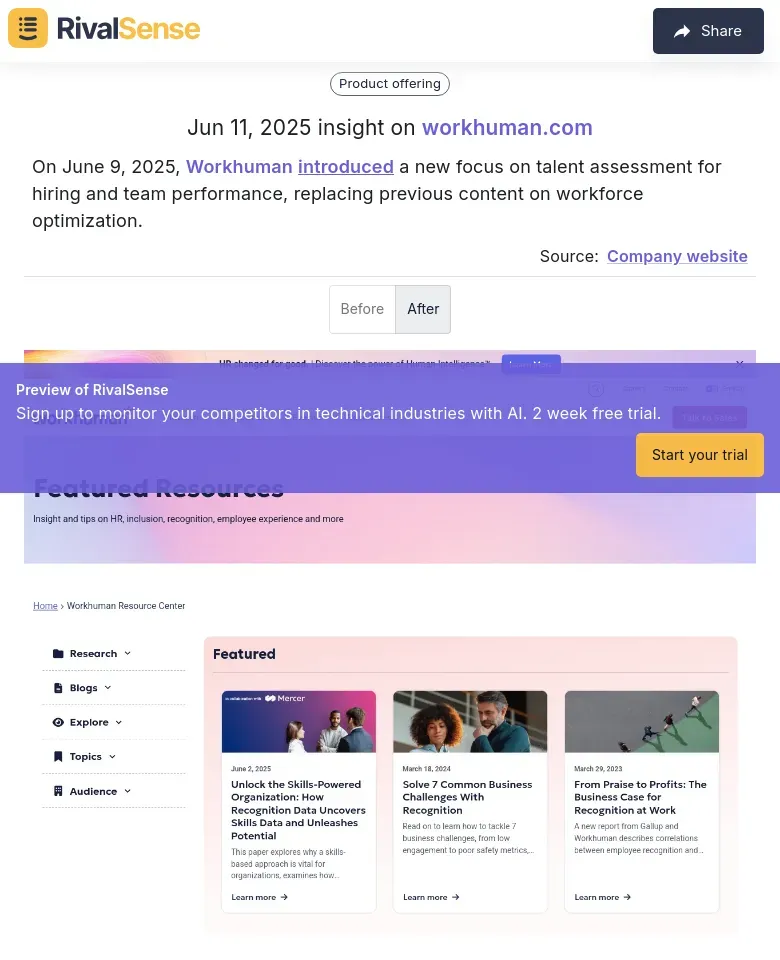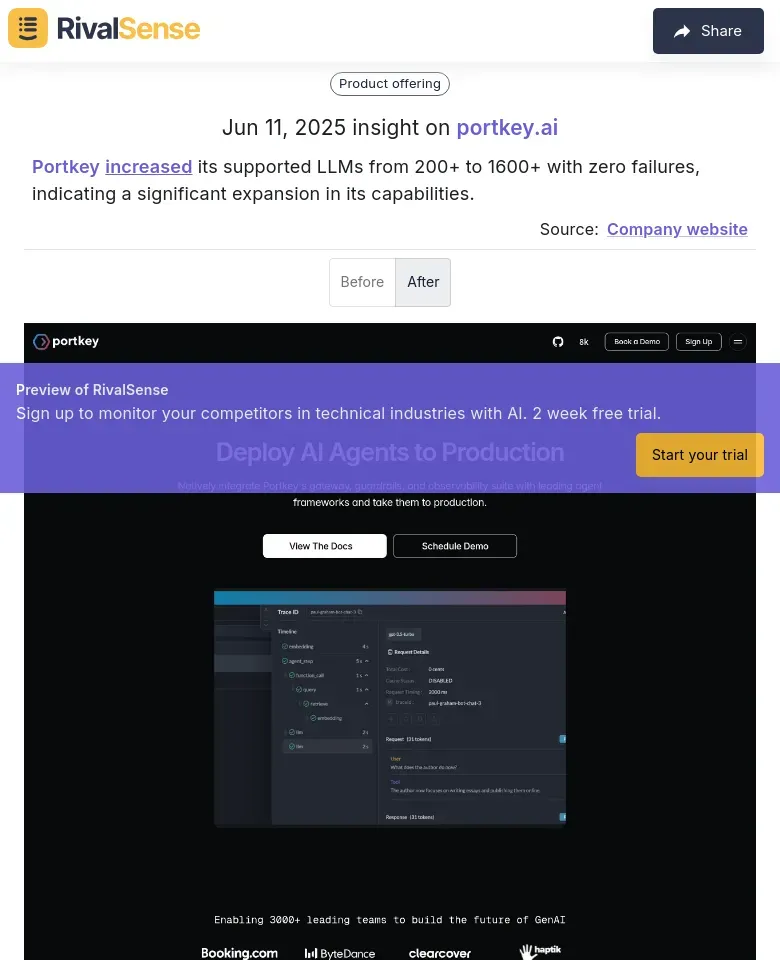5 Product Offering Mistakes When Tracking Competitor Promotions
In the fast-paced world of B2B markets, competitor tracking is not just about keeping tabs on rivals—it's a strategic tool that informs decision-making and shapes product offerings. By analyzing competitor promotions, businesses can uncover shifts in focus, emerging market trends, and potential gaps in their own strategies. Ignoring these movements can lead to missed opportunities or, worse, a product lineup that's out of sync with market demands.
Practical steps to leverage competitor tracking include:
- Regular Monitoring: Set up alerts or use tools to track competitor promotions in real-time.
- Analyze Patterns: Look for recurring themes or timing in promotions to predict future moves.
- Benchmark Against Your Offerings: Compare competitor promotions with your own to identify strengths and weaknesses.
- Adjust Strategically: Use insights to refine your product offerings, ensuring they meet current market needs.
💡 Tip: Create a checklist for each competitor promotion you track, noting the product, discount, duration, and unique selling points for quick comparisons.
Mistake 1: Overlooking Shifts in Competitor Focus
Failing to notice when competitors pivot their strategic focus is a critical oversight. These shifts often signal emerging market opportunities or threats before they become mainstream trends. Early detection allows you to proactively adjust your product positioning rather than playing catch-up.
For example, RivalSense detected that on June 9, 2025, Workhuman introduced a new focus on talent assessment for hiring and team performance, replacing previous content on workforce optimization:

Tracking such messaging changes is invaluable because it reveals strategic realignments that could impact market share. When competitors pivot, it often indicates validated customer needs you might be overlooking.
How to Identify and Analyze Shifts:
- Monitor Messaging Changes: Review competitors' websites, blogs, and social media weekly for new keywords or themes.
- Track Product Updates: Set alerts for announcements about new features or services.
- Analyze Customer Feedback: Mine competitor reviews for unmet needs they're addressing.
Strategies to Adapt:
- 📊 Compare shifts against industry trend reports
- 🔍 Audit your product gaps relative to their new focus
- 🎯 Adjust roadmap quarterly based on findings
✅ Action Checklist:
- [ ] Use automated tools for real-time shift detection
- [ ] Conduct positioning analysis every quarter
- [ ] Brief sales teams on new competitor narratives
Mistake 2: Ignoring Expansions in Competitor Capabilities
Underestimating competitor capability upgrades can leave your offerings looking outdated overnight. Technological expansions often indicate where the market is heading and what customers now expect as table stakes. Proactive monitoring turns these insights into R&D opportunities rather than threats.
Consider how Portkey recently increased its supported LLMs from 200+ to 1600+ with zero failures:

Tracking capability expansions matters because they reveal technical benchmarks and scalability standards. When competitors enhance offerings without failures, it signals reliable innovation worth reverse-engineering.
Benchmarking Your Capabilities:
- Identify Key Areas: Focus on expansions aligning with your roadmap (e.g., API integrations).
- Assess Impact: Evaluate how changes affect customer value perception.
- Gap Analysis: Compare your tech stack against new competitor features.
- Action Plan: Develop counter-features or unique differentiators.
🔧 Practical Tips:
- Subscribe to competitor product update newsletters
- Conduct quarterly technical capability audits
- Run customer surveys comparing feature satisfaction
Mistake 3: Neglecting Annual Reports and Strategic Shifts
Annual reports are treasure troves of strategic intelligence often overlooked in daily tracking. These documents reveal long-term visions, financial health, and R&D priorities that shape future market landscapes. Skipping them means missing early indicators of disruptive moves.
Notice how Isometric's latest annual report signaled a strategic shift by including Biochar and Direct Air Capture in its offerings:

Analyzing annual reports provides unparalleled value because they disclose validated strategic bets before competitors fully execute them. This foresight lets you build counter-strategies or explore adjacent opportunities.
Practical Analysis Framework:
- Schedule Reviews: Calendar annual report analyses for top competitors
- Focus Sections: Prioritize CEO letters, financial outlooks, and R&D allocations
- Trend Comparison: Chart year-over-year priority changes
- Validation: Cross-reference with patents, hiring patterns, and partnerships
📌 Key Sections to Watch:
| Section | Strategic Value |
|---|---|
| CEO Letter | Cultural shifts & vision changes |
| R&D Investment | Future capability bets |
| Market Analysis | New verticals or customer segments |
Mistake 4: Failing to Differentiate Based on Competitor Moves
Blindly mirroring competitor promotions commoditizes your offerings and erodes pricing power. Differentiation requires turning competitor intelligence into unique value propositions rather than imitation. Strategic responses should amplify your distinct strengths while addressing gaps they expose.
Effective Differentiation Tactics:
- Gap Exploitation: If competitors discount heavily, bundle with premium support
- Strength Amplification: When they compete on price, emphasize your superior outcomes
- Niche Targeting: Address customer segments their promotions overlook
Real-World Examples:
- ✨ A SaaS company added personalized onboarding to free trials after noticing competitors lacked support
- 💡 An e-commerce brand launched "buy now, pay later" instead of matching discounts
📋 Differentiation Checklist:
- [ ] Map competitor promotions against your unique value pillars
- [ ] Identify 3 underserved customer needs in their campaigns
- [ ] Test differentiation concepts through small-scale pilots
Mistake 5: Underestimating the Speed of Competitor Innovation
Complacency around competitor innovation velocity is a silent growth killer. Today's minor feature update can become tomorrow's industry standard faster than most anticipate. Building an early-warning system ensures you're the disruptor, not the disrupted.
Innovation Tracking System:
- Real-Time Monitoring: Dedicate weekly slots to review competitor updates
- Automated Alerts: Leverage tools for instant product change notifications
- Impact Assessment: Gauge customer reactions through forums and reviews
- Cross-Functional Response: Create SWAT teams to act on critical insights
🚀 Innovation Acceleration Checklist:
- [ ] Set up keyword alerts for competitor + "launch/update"
- [ ] Conduct monthly innovation benchmarking sessions
- [ ] Reverse-engineer competitor product changes quarterly
Conclusion: Turning Competitor Insights into Strategic Advantages
Avoiding these five mistakes—overlooking focus shifts, ignoring capability expansions, neglecting annual reports, failing to differentiate, and underestimating innovation speed—transforms competitor tracking from defensive surveillance to offensive strategy. The key lies in systematic analysis and rapid execution.
Implementation Blueprint:
- Prioritize: Identify 3 competitors that impact your revenue most
- Track: Monitor promotions, capabilities, reports, and innovations
- Analyze: Schedule monthly deep-dives to extract actionable patterns
- Act: Build a 90-day response plan for critical insights
💡 Pro Tip: The most successful companies institutionalize competitor intelligence with cross-functional workflows between product, marketing, and sales teams.
Ready to Master Competitor Tracking?
Manually monitoring website changes, social media, registries, and reports across multiple competitors consumes precious bandwidth. RivalSense automates this process by tracking competitor product launches, pricing updates, event participations, partnerships, and strategic shifts—delivering actionable insights in a weekly email digest.
Get your first competitor report today and transform intelligence into advantage:
Try RivalSense Free
📚 Read more
👉 The Power of Timely Information: How to Stay Ahead in Business
👉 Decoding Citadel's Commodities Tech Stack Shift: Strategic Implications
👉 Citadel's Risk Platform Centralization: Insights & Competitive Response Tactics
👉 How to Monitor Competitive Threats: A Practical Guide for Business Leaders
👉 HVAC Competitor Webinar Strategy Cheat Sheet: Outperform with Actionable Insights
